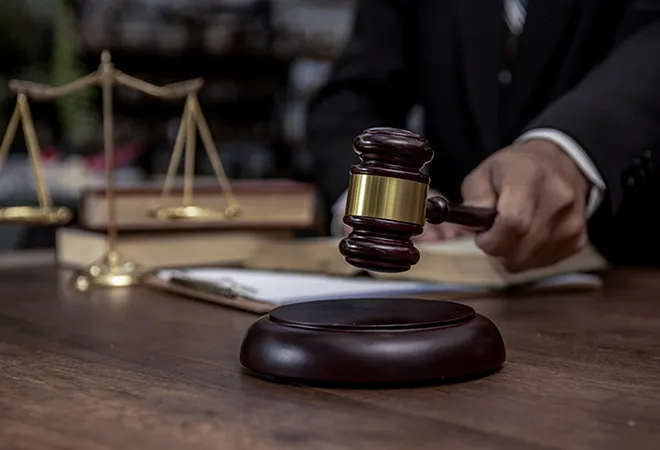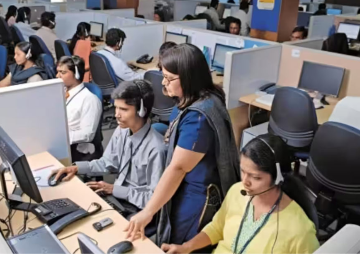 This piece is part of the series, India @75: Assessing Key Institutions of Indian Democracy.
This piece is part of the series, India @75: Assessing Key Institutions of Indian Democracy.
Introduction
In strengthening democracy and liberal values in India, the judiciary has played an extremely critical role: From being the guardian of the Constitution, an able protector of rights of the poor and disadvantaged groups against state excesses to an institution of last resort for millions of citizens. With some exceptions, for most of the last 75 years, the Indian Judiciary has been able to protect the Constitution and uphold the rule of law. It continues to be so notwithstanding the numerous ups and downs that it has been seen as a counter-majoritarian institution of governance. The judiciary has had its own share of critical concerns about reforms in terms of the manner of appointments of judges and growing backlog, accountability, corruption, issues of access and affordability of justice for average citizens, and so on. This brief is an attempt to capture some of the key developments in judicial evolution and to draw insights into the roles of courts in strengthening democracy and personal liberty in post-independent India.
The judiciary has had its own share of critical concerns about reforms in terms of the manner of appointments of judges and growing backlog, accountability, corruption, issues of access and affordability of justice for average citizens
Evolution:
First Phase
In its 75 years of eventful journey, the Indian judiciary had many avatars. In the early years of independence, the higher courts used the restricted confines of the judicial challenges to act as a check on legislative enactments which was largely exercised through the
power of judicial review. Three dominant aspects of the early years of the judiciary stand out: First, it adhered to the constitutional text; second, it refused to get swayed by ideologies (socialism, affirmative action/reservation policy) of the government; third, the legislative prudence to have
plenary power to amend the Constitution was held to be the correct approach. Thus, although the judiciary declared
zamindari abolition as illegal and a violation of the right to property in the
Kameshwar Prasad case, it avoided using the provision of judicial review when the Parliament quickly passed the first amendment to the Constitution to keep the provision out of the purview of judicial review. Similarly, in
Champakam Dorairajan, the court struck down the central government’s decision to have reservations in educational institutions based on caste as a violation of the right to equality (under Article 14), avoiding institutional confrontation with the Parliament. In all these instances, the judiciary followed a
positivist interpretation of the Constitution.
Second Phase
The second phase which was tumultuous and politically charged commenced with the
Golak Nath judgment; here the judiciary entered the political water with its expansive interpretation of fundamental rights. The Supreme Court (SC) reconsidered the constitutionality of the 17
thAmendment and by a majority, verdict declared the said amendment illegal. Thus, it overruled
Sankari Prasad and
Sajjan Singh cases where it had avoided a confrontation with the Parliament. The court ruled that the amending power of the Parliament was subject to fundamental rights tests. In short, the SC denied the Parliament its legislative sovereignty and
restored its power of judicial review even on matters related to the right to property. This prepared a stage for a confrontation between the judiciary and Parliament. To re-establish its supremacy, the Parliament passed
24th Amendment which reversed
Golak Nath.
The court ruled that the amending power of the Parliament was subject to fundamental rights tests. In short, the SC denied the Parliament its legislative sovereignty and restored its power of judicial review even on matters related to the right to property.
This amendment by the Parliament led the court to deliver the historic
Keshavananda Bharati judgment that imposed restrictions on the Parliament’s sovereign power to amend the Constitution. A 1313-judge constitutional bench of the SC in a majority verdict (7 judges supported) ruled that while the Parliament was supreme to amend the Constitution, under Article 368, it cannot alter the ‘
basic structure’ of the Constitution. This verdict opened up further resistance from the government. It is all too well known what followed was the unprecedented supersession of three senior-most judges to appoint Justice AN Ray as the Chief Justice of India. The ensuing confrontation reached its peak in the
Raj Narain case involving the validity of Prime Minister Indira Gandhi’s election. The Allahabad High Court which nullified Mrs Gandhi’s election and subsequent declaration of Emergency in June 1975, set the stage for a sharp marginalisation of the judiciary. The national emergency and the supersession of judges, which are believed to have led to increased politicisation of the judiciary, majorly contributed to the meek judicial surrender in the controversial
ADM Jabalpur vs. Shivkant Shukla which supported the government’s act of suspending the right to life under Article 21 of the fundamental rights. This judgement marked a new low for Constitutional democracy in the country besides exposing the institutional vulnerability of the higher judiciary.
Third Phase
The post-ADM-Jabalpur phase led to institutional churning of the courts, and the constitutional courts, in particular, did not waste any time in correcting its course at the earliest possible opportunity. Although the judgement in ADM Jabalpur continued to be on the law reports, to be overturned explicitly at a much-belated stage, the judiciary as an institution was eager to course correct. To undo the damages made during the national emergency, the court in
Maneka Gandhi vs. Union of India and subsequent decisions widened the scope of Article 21 to give a wide meaning to “Right to Life”. In the
Maneka Gandhi case, the judiciary opened up a new dimension of to life and personal liberty when it laid down that Article 21 encompasses within itself all such actions that make life meaningful, and provided a new meaning to the procedure established by law to include, fairness, justness, and non-arbitrariness.
The court granted workers, residents, and the general public the right to appeal to the courts against violation of their collective rights.
Thus, gradually, the judiciary fashioned an era of judicial activism through an expansive interpretation of fundamental rights by creatively using public interest litigation (PIL). The starting point of the PIL revolution was with landmark
S.P. Gupta vs. President of India and others. While delivering the judgment, Justice P.N. Bhagwati held that “any member of the public acting
bona fide and having sufficient interest in instituting an action for redressal of public wrong or public injury could move the court”. Thus, the court granted workers, residents, and the general public the right to appeal to the courts against violation of their collective rights. In the same breath, the judiciary treated the letters written to it as writ petitions as it would expand ‘access to justice’. The court’s active promotion of PIL encouraged scores of public-spirited individuals, lawyers, and NGOs to file litigations on all kinds, of issues ranging from human rights violations, women’s rights, child rights, bonded labour, environmental pollution, and even constitutional and governance issues. Thus, in every sense,
PIL heralded an era of judicial activism in India. Through PIL, the court creatively expanded substantive rights (i.e., the Fundamental Rights, especially Article 21) to cover implicit rights such as the right to live with human dignity, the right to livelihood, and the right to a healthy environment.
Beyond PIL which significantly strengthened the grip of the judiciary, this phase of judicial activism saw the court bestowing power to appoint judges upon themselves. Apart from trying to maintain autonomy by insulating from the executive interferences in judicial appointments, the decision was meant to further cement judicial dominance in a period marked by weak coalition governments. The judiciary did this in a series of judgments known as
three judges cases. The Supreme Court in the
third judges case in 1998 called for the creation of a collegium system where other judges also are actively consulted for appointments.
The collegium system (where judges appoint themselves) was sought to be replaced by the National Judicial Appointments Commission in 2015. The government passed the legislation to set up the National Judicial Appointments Commission (NJAC) to make a judicial appointment a not-so-exclusive judicial with minimal executive interference. However, the act had certain provisions that were concerning. Seeing this as an attempt by the executive to take away the power of appointment from them, a five-member SC bench declared the new law
unconstitutional. Thus, the judiciary strongly stood to any possible executive interference in matters of appointment of judges.
The government passed the legislation to set up the National Judicial Appointments Commission (NJAC) to make a judicial appointment a not-so-exclusive judicial with minimal executive interference.
Fourth Phase
The fourth phase begins in 2014 when after a hiatus of more than 3three decades a single party enjoyed an overwhelming majority. The institutional positioning of the executive, legislature and judiciary were once again under scrutiny. While there is
criticism that the judiciary has been delivering pro-executive judgements, and has not lived up to the mark in protecting the lives and personal liberties of individuals, there are instances of humanitarian crisis where the courts particularly the high courts and SC have ensured that the basic fundamental right to life, food, health, dignity is protected. Several
Suo Motto proceedings initiated by the SC and the high courts in the last two years are testimony to the fact that the activism in the courts still stands strong.
Conclusion
It is quite evident, notwithstanding the judiciary’s varied responses at different times in the history of the nation, that it has played an extremely vital role in strengthening and safeguarding freedom and democracy in India. For a large part of its evolution, the judiciary has played a significant role as an institution of last resort against the executive and legislative branches. However, with an unprecedented strengthening of either the executive power having centralising tendencies, the judiciary has taken back foot on more than one occasion and has nevertheless resurrected itself as an accountable institution, marking the real success of rule of law. While institutional interaction is to be discussed and understood, it is time that individual challenges faced by each organ are introspected and a solution needs to be found. Thus, as the country celebrates 75 years of independence, the time is ripe for judicial introspection and action to make justice a reality for all.
The views expressed above belong to the author(s). ORF research and analyses now available on Telegram! Click here to access our curated content — blogs, longforms and interviews.



 This piece is part of the series,
This piece is part of the series,  PREV
PREV



